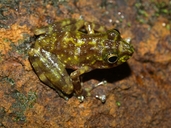|
Description
A member of the Mantidactylus boulengeri-group, which contains M. boulengeri, M. boulengeri "leucocephalus", M. decaryi, M. eiselti, M. thelenae, M. klemmeri and M. webbi. This group is composed of rather small species (20-35 mm). Lateral metatarsalia are connected. An outer metatarsal tubercle is present, with the exception ofM. webbi. Webbing is absent between the fingers and reduced between the toes, except for M. webbi, in which the feet are moderately webbed. Nostrils are situated nearer to the tip of the snout than the eye. Males have paired subgular vocals sacs which are white in M. webbi and dark in the other species. Femoral glands are distinct in males, absent in females. These frogs are active and call mainly during the day. M. webbi and M. klemmeri live on mossy stones along brooks; calling males of the other species do not aggregate around water. Direct development has been observed in M. eiselti. On the lip, alternating light and dark transverse bands are present, as in the subgenus Brygoomantis, whose species are also mainly terrestrial with at least partial diurnal activity. Representatives can be distinguished from most other species of Mantidactylus by the paired subgular vocal sacs of males, only also present in the M. granulatus-group, which is composed of larger and mainly nocturnal species (references 97 and 252; for references in text see Comments, below).
Mantidactylus webbi (GRANDISON, 1953) is a medium-sized greenish species of Mantidactylus; males 22-28 mm, females 28-33 mm. Dorsal colouration similar to mossy stones: greenish with irregular dark spots, and two or three dark transverse bands. Ventral surface whitish, less pigmented. Throat with some dark colour. Hind legs with dark bands. The omosternum not distinctly forked. Skin finely granular. Tympanum distinct, about 2/5-1/2 of eye diameter. Tibiotarsal articulation reaches at least the nostrils. Lateral metatarsalia connected. Hands without webbing; webbing of the foot 1(1), 2i(1), 2e(1), 3i(2), 3e(1-2), 4i/e(2.5-3), 5(2). Males with white (!), paired subgular vocal sacs and femoral glands.
Similar species: So far as known, M. webbi is the only Malagasy frog with white, paired subgular vocal sacs. The most similar species is M. klemmeri.
Distribution and Habitat
Country distribution from AmphibiaWeb's database: Madagascar
Forest near Andranofotsy, Navana, Nosy Mangabe, Voloina. It occurs between sea level and 100m asl in rainforest, generally along rocky streams among boulders and moss (Andreone and Vences 2008).Life History, Abundance, Activity, and Special Behaviors
Habits: Activity and calls were noticed only during the day; jumps on big mossy stones along brooks in primary forest. Never found at distances of more than 20 m from the water (ref. 252).
Call (from the terra typica, 23 °C): The call is a series of up to 10 unharmonious notes. Note duration 26-46 ms, duration of the interval 122-168 ms, note repetition rate 6.25/s and frequency ranges from 0.5-5kHz. Calls are less intense than those of other species of this group.
Eggs and tadpoles (from the terra typica): Two egg clumps (one in March and one in August), each with 7 yellowish eggs (diameter 4 mm), probably belonging to this species, were found on rocks above a brook in primary forest. One of them was guarded by a male (ref. 13). Tadpoles unknown. Juveniles of 10 mm SVL were found.
Breeds occurs along streams under mossy boulders; eggs are laid on rocks (Andreone and Vences 2008). Trends and Threats
Endangered: extent of occurrence is less than 5,000 km2 and its area of occupancy is less than 500 km2, its distribution is severely fragmented, and there is continuing decline in the extent and quality of its habitat in northeastern Madagascar. It occurs in the Réserve Spéciale de Nosy Mangabe, but is not yet confirmed from Parc National de Masoala (Andreone and Vences 2008). Possible reasons for amphibian decline General habitat alteration and loss
Habitat modification from deforestation, or logging related activities
Intensified agriculture or grazing
Urbanization
Habitat fragmentation
Comments
Taken with permission from Glaw and Vences (2007).
References
Andreone, F. and Vences, M. (2008). Gephyromantis webbi. In: IUCN 2008. 2008 IUCN Red List of Threatened Species. www.iucnredlist.org. Downloaded on 14 April 2009.
Glaw, F., and Vences, M. (2007). Field Guide to the Amphibians and Reptiles of Madagascar. Third Edition. Vences and Glaw Verlag, Köln.
Originally submitted by: Miguel Vences and Frank Glaw (first posted 2000-11-30)
Edited by: Henry Zhu (2009-05-06)Species Account Citation: AmphibiaWeb 2009 Gephyromantis webbi <https://amphibiaweb.org/species/4630> University of California, Berkeley, CA, USA. Accessed May 1, 2024.
Feedback or comments about this page.
Citation: AmphibiaWeb. 2024. <https://amphibiaweb.org> University of California, Berkeley, CA, USA. Accessed 1 May 2024.
AmphibiaWeb's policy on data use.
|
